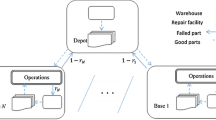Abstract
Many enterprises that use expensive capital goods outsource the process of spare parts supply and stocking to a maintenance-, repair-, and overhaul provider (MRO-provider). Because of the high value, these spare parts are stocked in repairable item systems, in which defective parts are repaired after removal from the machine and put back into stock. When setting inventory levels, the providers do not consider all of the spare parts that are stocked in the system because customers hold own stock to bridge the delivery time from the MRO-provider. As these spare parts are not property of the MRO-provider, the provider does not take them into account when planning inventory, incurring overstocking at the central depot. A model, which considers customer stock when determining depot inventory levels, is developed by extending the METRIC model with a heuristics. The heuristics calculates backorder levels according to the depot inventory levels as well as customer stock levels and allows for an inventory reduction. Using the proposed model, savings of depot inventory can be up to 100 %, while keeping the backorder level of part requests below a preset threshold.





Similar content being viewed by others
References
Baines T, Lightfoot H, Benedettini O, Whitney D, Kay J (2010) The adoption of servitization strategies by UK-based manufacturers. J Eng Manuf 224:815–829
Eickemeyer S, Borcherding T, Schäfer S, Nyhuis P (2013) Validation of data fusion as a method for forecasting the regeneration workload for complex capital goods. Prod Eng. doi:10.1007/s11740-013-0444-8
Denkena B, Bluemel P, Kroening S, Roebbing J (2012) Condition based maintenance planning of highly productive machine tools. Prod Eng. doi:10.1007/s11740-011-0351-9
Muckstadt JA (2005) Analysis and algorithms for service parts supply chains. Springer, New York
Basten RJI, van Houtum GJ (2014) System-oriented inventory models for spare parts. Surv Oper Res Manag Sci. doi:10.1016/j.sorms.2014.05.002
Tracht K, Mederer M, Schneider D (2011) Effects of lateral transshipments in multi-echelon closed-loop supply chains. In: Hesselbach J, Herrmann C (eds) Glocalized solutions for sustainability in manufacturing. Springer, Berlin Heidelberg, pp 443–447
Wong H, Kranenburg B, van Houtum GJ, Cattrysse D (2007) Efficient heuristics for two-echelon spare parts inventory systems with an aggregate mean waiting time constraint per local warehouse. OR Spectr 29:699–722
Gümüs T, Güneri F (2007) Multi-echelon inventory management in supply chains with uncertain demand and lead times: literature review from an operational research perspective. J Eng Manuf 221:1553–1570
Sleptchenko A, van der Heijden MC, van Harten A (2005) Using repair priorities to reduce stock investment in spare part networks. Eur J Oper Res. doi:10.1016/j.ejor.2004.02.002
Tracht K, Funke L, Schneider D (2014) Varying repair capacity in a repairable item system. Procedia CIRP. doi:10.1016/j.procir.2014.01.064
Leung KNF, Zhang YL, Lai KK (2010) Optimal replacement policy for a two-component cold standby system with repair priority. Proc Inst Mech Eng, Part B. doi:10.1243/09544054JEM1675
Nyhuis P (2007) Practical applications of logistic operating curves. CIRP Ann Manuf Technol. doi:10.1016/j.cirp.2007.05.115
Nyhuis P, Schmidt M, Wriggers FS (2008) Reduction of capital tie up for assembly processes. CIRP Ann Manuf Technol. doi:10.1016/j.cirp.2008.03.019
Schmidt M, Hartmann W, Nyhuis P (2012) Simulation based comparison of safety-stock calculation methods. CIRP Ann Manuf Technol. doi:10.1016/j.cirp.2012.03.054
Stoll J, Kopf R, Schneider J, Lanza G (2015) Criticality analysis of spare parts management: a multi-criteria classification regarding a cross-plant central warehouse strategy. Prod Eng. doi:10.1007/s11740-015-0602-2
Tracht K, von der Hagen F, Schneider D (2013) Applied repairable-item inventory modeling in the aviation industry. Procedia CIRP. doi:10.1016/j.procir.2013.07.020
Alvarez EM, van der Heijden MC, Zijm WHM (2013) Service differentiation in spare parts supply through dedicated stocks. Ann Oper Res. doi:10.1007/s10479-013-1362-z
Tracht K, Mederer M, Schneider D (2012) Impact of parameter changes in a service provider closed-loop supply chain with customer-owned-stock. In: Dornfeld DA, Linke BS (eds) Leveraging technology for a sustainable world. Springer, Berlin Heidelberg, pp 593–598
Sherbrooke C (2004) Optimal inventory modeling of systems, 2nd edn. Kluwer Academic Publishers Group, New York
Alfredsson P, Verrijdt J (1999) Modeling emergency supply flexibility in a two-echelon inventory system. Manag Sci 45:1416–1431
Kleinrock LRG (1975) Queueing systems, vol 1. Wiley, New York
Acknowledgments
The results presented in this paper were developed in the research project dLP– dynamic LRU planning (03CL02H). dLP was part of the Aviation Cluster of the Metropolitan Region Hamburg funded by the German Federal Ministry of Education and Research (BMBF).
Author information
Authors and Affiliations
Corresponding author
Rights and permissions
About this article
Cite this article
Schneider, D., Tracht, K., Meyer-Stender, M. et al. Customer stock in repairable item systems. Prod. Eng. Res. Devel. 10, 209–216 (2016). https://doi.org/10.1007/s11740-015-0654-3
Received:
Accepted:
Published:
Issue Date:
DOI: https://doi.org/10.1007/s11740-015-0654-3




